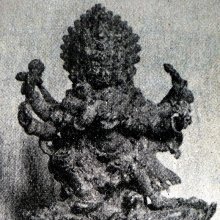Prajnantaka, Prajñāntaka: 5 definitions
Introduction:
Prajnantaka means something in Buddhism, Pali, Hinduism, Sanskrit. If you want to know the exact meaning, history, etymology or English translation of this term then check out the descriptions on this page. Add your comment or reference to a book if you want to contribute to this summary article.
Images (photo gallery)
In Buddhism
Tibetan Buddhism (Vajrayana or tantric Buddhism)
Source: archive.org: The Indian Buddhist IconographyPrajñāntaka (प्रज्ञान्तक) presides over the south and represents one of the ten deities of the quarters (Dikpāla) commonly depicted in Buddhist Iconography, and mentioned in the 11th-century Niṣpannayogāvalī of Mahāpaṇḍita Abhayākara.—His Colour is white; he has three faces and six arms.—The second deity in the series is Prajñāntaka who presides over the Southern direction.
Prajñāntaka is described in the Niṣpannayogāvalī (mañjuvajra-maṇḍala) as follows:—
Source: academia.edu: The Structure and Meanings of the Heruka Maṇḍala“In the South, there is Prajñāntaka, who is white in colour having three faces of white, blue and red colour. In his four hands he shows the white staff marked with a vajra, the sword, the jewel and the lotus.”
[The two other hands hold the śakti. In the vajrahūṃkāra-maṇḍala his second name is given as Vajrakuṇḍalī.]
Prajñāntaka (प्रज्ञान्तक) is the name of a Vīra (hero) who, together with the Ḍākinī named Prajñāntakī forms one of the 36 pairs situated in the Hṛdayacakra, according to the 10th century Ḍākārṇava chapter 15. Accordingly, the hṛdayacakra refers to one of the four divisions of the sahaja-puṭa (‘innate layer’), situated within the padma (lotus) in the middle of the Herukamaṇḍala. The 36 pairs of Ḍākinīs and Vīras [viz., Prajñāntaka] are reddish yellow in color; they each have one face and four arms; they hold a skull bowl, a skull staff, a small drum, and a knife.

Tibetan Buddhism includes schools such as Nyingma, Kadampa, Kagyu and Gelug. Their primary canon of literature is divided in two broad categories: The Kangyur, which consists of Buddha’s words, and the Tengyur, which includes commentaries from various sources. Esotericism and tantra techniques (vajrayāna) are collected indepently.
General definition (in Buddhism)
Source: Wisdom Library: Dharma-samgrahaPrajñāntaka (प्रज्ञान्तक) refers to the second of the “ten wrathful ones” (daśakrodha) as defined in the Dharma-saṃgraha (section 11). The Dharma-samgraha (Dharmasangraha) is an extensive glossary of Buddhist technical terms in Sanskrit (e.g., daśa-krodha and Prajñāntaka). The work is attributed to Nagarguna who lived around the 2nd century A.D.
Languages of India and abroad
Sanskrit dictionary
Source: Cologne Digital Sanskrit Dictionaries: Edgerton Buddhist Hybrid Sanskrit DictionaryPrajñāntaka (प्रज्ञान्तक).—name of one of the ten krodha: Dharmasaṃgraha 11; Sādhanamālā 137.8.
Source: Cologne Digital Sanskrit Dictionaries: Monier-Williams Sanskrit-English DictionaryPrajñāntaka (प्रज्ञान्तक):—[=pra-jñāntaka] (jñāt) m. ‘destroyer of w°’, (with, [Buddhist literature]) one of the 10 gods of anger, [Dharmasaṃgraha 11.]
Sanskrit, also spelled संस्कृतम् (saṃskṛtam), is an ancient language of India commonly seen as the grandmother of the Indo-European language family (even English!). Closely allied with Prakrit and Pali, Sanskrit is more exhaustive in both grammar and terms and has the most extensive collection of literature in the world, greatly surpassing its sister-languages Greek and Latin.
See also (Relevant definitions)
Partial matches: Pra.
Full-text: Vajrakundali, Dashakrodha, Ten Wrathful Ones, Prajnantaki, Hridayacakra, Vighnantaka.
Relevant text
Search found 1 books and stories containing Prajnantaka, Prajñāntaka, Pra-jnantaka, Pra-jñāntaka; (plurals include: Prajnantakas, Prajñāntakas, jnantakas, jñāntakas). You can also click to the full overview containing English textual excerpts. Below are direct links for the most relevant articles:
The Indian Buddhist Iconography (by Benoytosh Bhattachacharyya)

